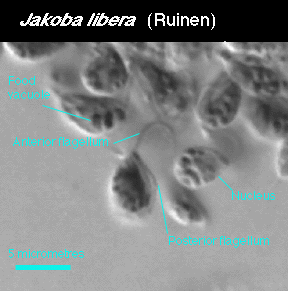Jakoba
Appearance
Jakobacells are found as naked freeswimming trophic
cells in marine environments.

 Trophic cells are ellipsoidal to slightly pear-shaped (the latter usually
when the
cells are compressed, as under a cover slip; or, when well fed, as in the
picture) and between 5 and 10 micrometers
long. Two flagella emerge from the anterior end of the cell. The
anterior flagellum is free; at rest, the flagellum often projects
anteriorly at first and then "hooks back" ventrally. The
posterior flagellum
normally remains in a groove that runs longitudinally along the ventral
surface of the cell, usually all the way to the posterior end. The groove is
defined by a cytoplasmic vane on the
right ventral side of the cell.
Bacteria are captured in
the ventral groove and are digested in food vacuoles. Cells swim in
straight lines, rotating along their longitudinal axes. They may also
"squirm" along a surface.
Trophic cells are ellipsoidal to slightly pear-shaped (the latter usually
when the
cells are compressed, as under a cover slip; or, when well fed, as in the
picture) and between 5 and 10 micrometers
long. Two flagella emerge from the anterior end of the cell. The
anterior flagellum is free; at rest, the flagellum often projects
anteriorly at first and then "hooks back" ventrally. The
posterior flagellum
normally remains in a groove that runs longitudinally along the ventral
surface of the cell, usually all the way to the posterior end. The groove is
defined by a cytoplasmic vane on the
right ventral side of the cell.
Bacteria are captured in
the ventral groove and are digested in food vacuoles. Cells swim in
straight lines, rotating along their longitudinal axes. They may also
"squirm" along a surface.
Return to summary information

 Trophic cells are ellipsoidal to slightly pear-shaped (the latter usually
when the
cells are compressed, as under a cover slip; or, when well fed, as in the
picture) and between 5 and 10 micrometers
long. Two flagella emerge from the anterior end of the cell. The
anterior flagellum is free; at rest, the flagellum often projects
anteriorly at first and then "hooks back" ventrally. The
posterior flagellum
normally remains in a groove that runs longitudinally along the ventral
surface of the cell, usually all the way to the posterior end. The groove is
defined by a cytoplasmic vane on the
right ventral side of the cell.
Bacteria are captured in
the ventral groove and are digested in food vacuoles. Cells swim in
straight lines, rotating along their longitudinal axes. They may also
"squirm" along a surface.
Trophic cells are ellipsoidal to slightly pear-shaped (the latter usually
when the
cells are compressed, as under a cover slip; or, when well fed, as in the
picture) and between 5 and 10 micrometers
long. Two flagella emerge from the anterior end of the cell. The
anterior flagellum is free; at rest, the flagellum often projects
anteriorly at first and then "hooks back" ventrally. The
posterior flagellum
normally remains in a groove that runs longitudinally along the ventral
surface of the cell, usually all the way to the posterior end. The groove is
defined by a cytoplasmic vane on the
right ventral side of the cell.
Bacteria are captured in
the ventral groove and are digested in food vacuoles. Cells swim in
straight lines, rotating along their longitudinal axes. They may also
"squirm" along a surface.